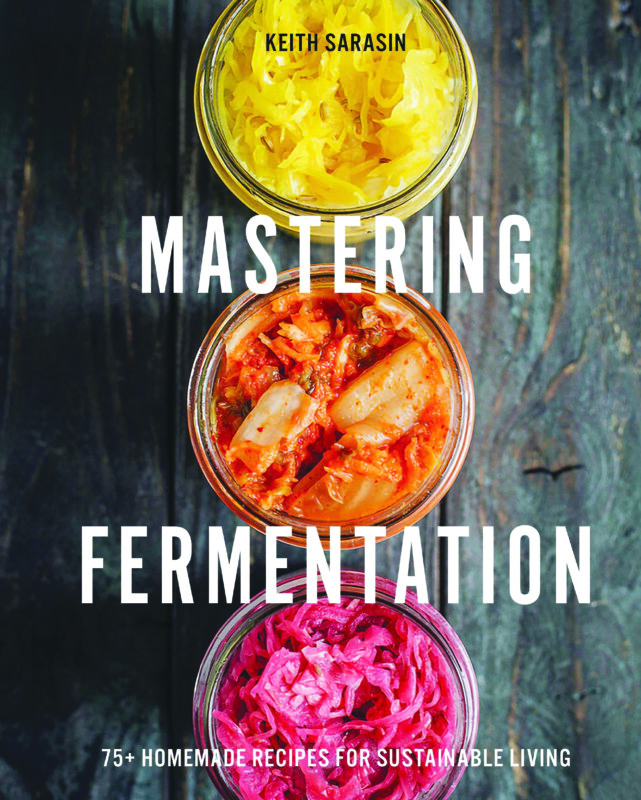Chef Sarasin’s new cookbook features fun flavors
According to local chef Keith Sarasin, humanity wouldn’t be where it is today if it weren’t for fermentation.
In his latest cookbook, Mastering Fermentation, which will be released on Tuesday, Sept. 26, Sarasin aims to show readers the beauty of fermentation while walking them through the process.
“This was a topic the publisher approached me with … and I asked them to focus on certain techniques,” Sarasin said. “I think if we said to anyone off the street [to] name a fermented dish, people might say kimchi or sauerkraut, but I wanted to move beyond just those things and really talk about why fermentation is such a backbone of culture and food.”
Sarasin says his passion for cooking comes from his mom. Growing up in Nashua with just his mother, he wanted to find ways that he could help. He started washing dishes at various restaurants and establishments, working his way up to an executive chef position. He also started working with local farms and in 2012 established the Farmers Dinner, which hosts dinners on various farms all throughout the region. Over time, Sarasin developed a passion for Indian food and culture, an area he now specializes in.
“I was a really picky eater when I was coming up working in kitchens and I think I had a lot of misconceptions about Indian cuisine like many people might,” he said. “One day I walked into a spice shop in Nashua called Food & Fashion of India and there was this lovely little lady in the back … and she kind of took me under her wing. After a lot of coaxing she helped me understand that there was so much more to Indian food than naan and chicken tikka masala. She really gave me my passion for the cuisine and helped me understand it, and subsequently she ended up becoming like a mother to me.”
For the past 16 years Sarasin has dedicated his studies to the cuisine and culture of the Indian subcontinent. He runs a pop-up series called Aatma — the name translates to “soul” — working with farms to bring this food to a new audience.
In Mastering Fermentation Sarasin, whose previous books include Meat: The Ultimate Cookbook and Wild Game Cooking, continues to expose people to new things. He feels there is a lot of confusion surrounding fermentation, a process he says has been used since 6000 BC to make alcohol and preserve food.
“I think a lot of time people think if you leave food out it spoils. I think we’re all taught that. But leaving food out can also lead to fermentation, which is so beautiful,” he said. “Fermentation involves really allowing naturally present or added microorganisms like bacteria, yeast, fungi and those enzymes to work their magic in the absence of oxygen. This leads to the killing of any pathogenic bacteria and creates an environment where beneficial bacteria can thrive.”
There are three types of fermentation to produce fermented foods at home, according to Sarasin: lactic acid fermentation to make things like pickles, yogurt and sourdough; alcohol fermentation to make beer and other alcoholic beverages; and acetic fermentation to produce vinegar and kombucha, among other things. In his book he gives a recipe for yogurt and whey fermented berries.
“I think people will realize this is a book to help you safely understand how to leave food out and turn it into a beautiful, fermented food,” Sarasin said. “Another thing I think people are going to realize very quickly and be surprised with is the amount of food that you can ferment to create wonderful healthy flavors really quickly.”
New book
Mastering Fermentation by Keith Sarasin (208 pages, Cider Hill Press) will be released Tuesday, Sept. 26.
Lacto-Fermented Carrots
From Keith Sarasin.
Serving size: Makes about 1 quart of lacto-fermented carrots (4-6 servings) Active time: 20 minutes Total time: 3-4 weeks
Traditional methods of preserving food and improving its nutritional content include lacto-fermentation. It entails using helpful bacteria called lactobacilli to transform the food’s carbohydrates into lactic acid. The food is preserved during this process, and the environment is made hostile to dangerous microorganisms. In addition to improving the food’s vitamin and enzyme content, lacto-fermentation also makes it more nutrient-dense and digestible.
Vegetables, dairy products and grains are among the foods that are frequently lacto-fermented. Foods that have undergone lacto-fermentation include sourdough bread, pickles, kimchi and sauerkraut.
Carrots that have been lacto-fermented are … a delicious complement to salads, sandwiches and other foods and have a somewhat sour, crunchy texture. The following is a straightforward recipe for lacto-fermented carrots.
Ingredients
4 cups grated carrots
2 Tablespoons fine sea salt
1 quart-sized jar with a tight-fitting lid
Directions:
In a large bowl, mix the grated carrots with the salt. Using your hands, massage the salt into the carrots for about 5 minutes, until the carrots start to release their liquid.
Transfer the carrots to the jar and press them down firmly. The liquid should cover the carrots. If necessary, you can add a little water to cover the carrots.
Close the lid tightly and place the jar in a cool, dark place for 3-4 weeks. Check the jar every few days to make sure the carrots are fermenting properly and to release any excess gas.
After 3-4 weeks, the lacto-fermented carrots should be ready. They will have a slightly sour, crunchy texture and a slightly cloudy appearance. If the carrots are not sour enough, you can leave them to ferment for a few more weeks.
Featured photo: Photo by Matthew Lomanno.






